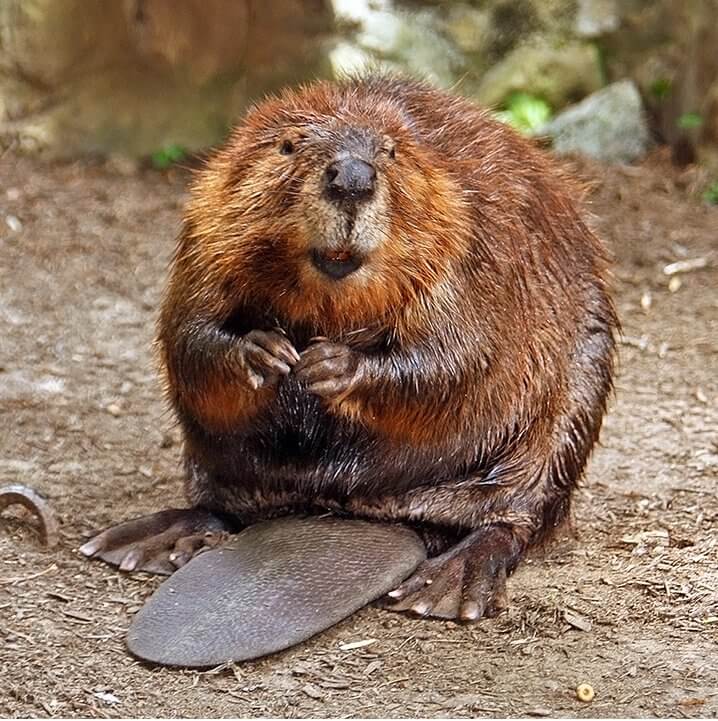Beaver Neighbor
By Rachel McKay
Broadcast 11.9 & 11.12.2022

American beaver. Photo by Flickr user Steve, CC BY-SA 2.0.
Listen:
I spotted a shadow moving swiftly under the water of Trout Creek in northwest Montana, and my heart started to race. My partner had called me outside just fifteen minutes before saying he saw something in the creek, and I had been stalking up and down the bank ever since. I noticed a wide flat tail propelling the shadowy animal forward, and suddenly its head popped up above the water. Two large black eyes considered its surroundings as it meandered upstream. I watched excitedly through my binoculars as it dove smoothly under willow roots and resurfaced near a boulder. After two years of living along this creek, I had finally seen the ever-elusive beaver! I hadn’t really known what beaver signs to look for though as just a novice beaver enthusiast.
It turns out that between food gathering and feats of engineering, beavers leave all kinds of marks on the landscape. They cut down small riparian trees with sharp front teeth, then awkwardly waddle back to the water with armfuls of branches. Beavers enjoy the carbohydrates and cellulose of the cambium layer, or inner bark. They also use trees as building material in their dams and lodges. They build dams by weaving trees together underwater and packing them with mud, altering the landscape to create a wetland habitat where beavers and other plant and animal species can thrive. The lodge is a large woody mound that rises out of the water like a small island with a hollow living space underneath for beavers and their large families. The underwater log base of the lodge ensures that they have easy access to river-refrigerated food all year round. To spot beaver signs, look for chewed tree stumps, dams, and lodges.
As I researched more about the magnificent creature I had seen, I learned that beavers have several key adaptations that help them with their work underwater. A transparent membrane drops over their eyes and a valve in each ear closes to keep out the water. Beavers have relatively poor eyesight, so their many long whiskers (which I had seen jutting from the beaver’s snout through my binoculars) help them detect debris as they swim up to six miles an hour. Beavers also have a second pair of lips behind their teeth so they can safely chew branches underwater.
Similarly, beavers are well adapted to living on land. They have sturdy tails that act as a tripod as they balance on their hind feet. Their spinal cord even extends into their scaly, flat tail giving them more control and power. Beavers’ tails also store needed fat for winter and help regulate body temperature by releasing their body heat. Beavers have another special adaptation on their hind feet: a preening toe. The second toe from the inside has a double toenail used to unmat their fur and remove burrs and parasites. They must keep their dense coat clean and brushed to maintain its waterproofing and insulating properties. In addition to their fur, beavers must take very good care of their long, curved front teeth. Their teeth continuously grow and are self-sharpening to maintain the ability to eat trees corn-on-the-cob style. They are only worn down to a manageable size through daily use.
I was thrilled to finally get my eyes on a beaver and see its presence in this landscape that beavers helped build. So many native plants and animals rely on beaver-shaped habitat, and humans are no exception. If you encounter lush meadows along trails in northwest Montana, look for signs of beavers. I hope to see my beaver neighbor again soon – and now I know what signs to look for.
Every week since 1991, Field Notes has inquired about Montana’s natural history. Field Notes are written by naturalists, students, and listeners about the puzzle-tree bark, eagle talons, woolly aphids, and giant puffballs of Western, Central and Southwestern Montana and aired weekly on Montana Public Radio.
Click here to read and listen to more Field Notes. Field Notes is available as a podcast! Subscribe on iTunes or wherever you listen to podcasts.
Interested in writing a Field Note? Contact Allison De Jong, Field Notes editor, at adejong [at] montananaturalist [dot] org or 406.327.0405.
Want to learn more about our programs as well as fun natural history facts and seasonal phenology? Sign up for our e-newsletter! You can also become a member and get discounts on our programs as well as free reciprocal admission to 300+ science centers in North America!












